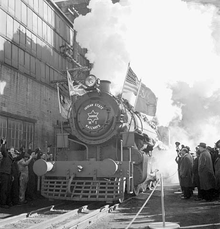Billion Dollar Gift and Mutual Aid

The Billion Dollar Gift and Mutual Aid were financial incentives instituted by the Canadian minister C. D. Howe during World War II.[1][2]
Background
Due to its expenditure on war materiel, Britain lacked gold reserves and U.S. dollars[3] to pay for existing and future orders with Canadian industry. At the same time, following expansion, Canadian industry was dependent on British contracts and before the war had had a positive balance of trade with the UK, but with the establishment of Lend-Lease, the UK secured future orders with the US. The Billion Dollar Gift was given to the UK in January 1942, coupled with a C$700 million non-interest bearing loan, both anticipated to last just over a year. It did not last until the end of 1942. It was replaced in May 1943 with the "War Appropriation (United Nations Mutual Aid) Act, 1943", which provided aid to the UK and the other Allies and lasted until the end of the war. The magnitude of these contributions made them one of Canada's greatest contributions to the war. The two grants totaled over C$3 billion.
Moreover, the Billion Dollar Gift triggered a strong negative reaction amongst Canadians, particularly in Quebec.[4] The rate at which the money was used was a key reason for the backlash, as was the lack of funding that was provided to the other nations in the Commonwealth.[5] The aftermath of the Gift led Canada's future funding to assist the Allies with an alternative approach - one that focused on loaning material goods instead of money.[4] A further consequence led to a change in the British Commonwealth Air Training Plan and this enabled another Canadian loan of just over $1 billion for Britain, Canada, Australia and New Zealand to share.[5]
In addition, Canada provided materiel and services, including food, ammunition, and raw materials, as well as corvettes, Park ships, and radar sets,[6][7][page needed] most of which went to the Commonwealth; some, like radars, also went to the U.S.[6][7][page needed] In 1943, Canada had the fourth-highest industrial production among the Allies, led by the United States, the Soviet Union and the United Kingdom.[8]
Canada also loaned $1.2 billion on a long-term basis to Britain immediately after the war; these loans were fully repaid in late 2006.[9]
See also
- British Commonwealth Air Training Plan
- Lend-Lease
- Valentine tank
- Military history of Canada during World War II
References
- ^ Mackenzie, Hector M. "Billion Dollar Gift". The Canadian Encyclopedia. Archived from the original on March 26, 2012. Retrieved 2012-08-20.
- ^ Hector M. Mackenzie. "Mutual Aid". The Canadian Encyclopedia. Archived from the original on 2012-10-17. Retrieved 2012-08-20.
- ^ Canadian Encyclopedia online (retrieved 20 December 2012)
- ^ a b Mackenzie, Hector (2012-05-02). "Transatlantic Generosity: Canada's 'Billion Dollar Gift' to the United Kingdom in the Second World War". The International History Review. 34 (2): 294–297. doi:10.1080/07075332.2011.626578. S2CID 154505663.
- ^ a b Bryce, Robert Broughton (2005). Bellamy, Matthew J. (ed.). Canada and the Cost of World War II: The International Operations of Canada's Department of Finance 1939-1947. McGill Queen's University Press. p. 84.
- ^ a b Milner, Marc. North Atlantic Run: The Royal Canadian Navy And the Battle for the Convoys. (Annapolis, Maryland. : Naval Institute Press, 1985)
- ^ a b Zimmerman, David. The Great Naval Battle of Ottawa (Toronto: University of Toronto Press, 1989.
- ^ Roberts, Leslie. C.D.: The Life and Times of Clarence Decatur Howe. (Toronto: Clarke, Irwin, and Company Limited, 1957). p 119-120
- ^ "Britain makes final WW2 lend-lease payment." Archived 2013-03-09 at the Wayback Machine Inthenews.co.uk. Retrieved: 8 December 2010.
Further reading
- Bryce. Robert B., & Bellamy, Matthew J. Canada And The Cost Of World War II: The International Operations Of Canada's Department Of Finance, 1939-1947. McGill-Queen's Press, 2005. ch 7
- Granatstein, J.L. Canada's War: The Politics of the Mackenzie King Government, 1939-1945 (1990) pp 311–16
- Mackenzie, Hector. "Transatlantic Generosity: Canada's 'Billion Dollar Gift'to the United Kingdom in the Second World War." International History Review 34.2 (2012): 293-314. online
- Mackenzie, Hector. "Sinews of War and Peace: The Politics of Economic Aid to Britain, 1939-1945," International Journal (1999) 54#4 pp. 648–670 in JSTOR
- Mackenzie, Hector M. "The Path to Temptation: The Negotiation of Canada's Reconstruction Loan to Britain In 1946," Historical Papers (1982), pp 196–220 online